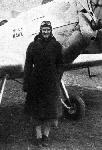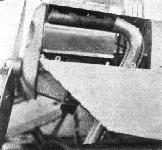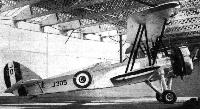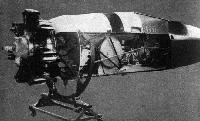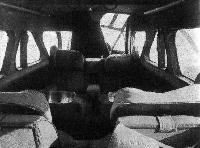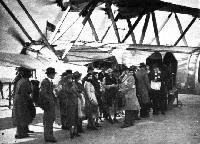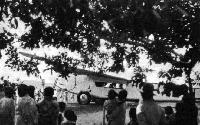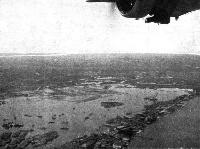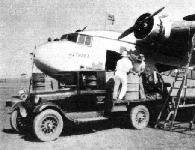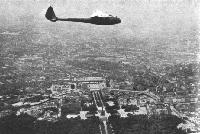Фотографии
-
Mr. Edwin Denis A. Bigg who, flying a Miles "Hawk" (Cirrus III), left for Nairobi, Kenya, last week. Mr. Bigg, who is an Ex-R.A.F. officer, is the first to fly one out to Africa, where he is going to start a Flying School and Air Taxi Company.
Самолёты на фотографии: Miles Hawk / M.2 - Великобритания - 1932
-
FOR LESS NOISE: This is the latest modification to the exhaust arrangements on the Miles "Hawk," as fitted to the machine of that make owned by Mrs. MacDonald.
Самолёты на фотографии: Miles Hawk / M.2 - Великобритания - 1932
-
SIXTY OF THEM IN SERVICE: A striking night photograph of one of the United Air Lines' new three-mile-a-minute Boeing 247 transports, halting briefly at Salt Lake City in the course of a Coast-to-Coast flight of less than 20 hours. All 60 of the new Boeings ordered by United, now are in regular service on the company's Coast-to-Coast, Pacific Coast, and other routes.
Самолёты на фотографии: Boeing Model 247 - США - 1933
-
Регистрационный номер: G-ACKA Самолёты на фотографии: Cierva/Avro C.30A / Rota - Великобритания - 1932
-
"LOOK PLEASANT, PLEASE": Mr. Juan de la Cierva and the C.30 P pose for the cameramen at Hanworth.
Самолёты на фотографии: Cierva/Avro C.30A / Rota - Великобритания - 1932
-
This photograph show the essential features of the Autogiro C.30 P. The front view shows how the Townend ring, round the 7-cylinder "Genet Major" engine, cleans up the design and accounts, no doubt, very largely for the increased performance of this type.
Самолёты на фотографии: Cierva/Avro C.30A / Rota - Великобритания - 1932
-
Регистрационный номер: PFA-J615 ON CIVIL (AIR) SERVICE: The Westland "Wapiti" ("Jupiter 8.F") with a closed-in back cockpit, faired away to the tail, is used by the Civil Air Board in South Africa.
Самолёты на фотографии: Westland Wapiti - Великобритания - 1927
-
WAITING FOR WEATHER: The Henry Potez T.O.E. biplanes ("Lorraine" engines) at Istres aerodrome in readiness to start the flight to Africa. General Vuillemin is in command.
Самолёты на фотографии: Potez Potez 25 - Франция - 1925
-
Регистрационный номер: J305 FOR EGYPT: This Avro 626 (Armstrong-Siddeley "Cheetah") is one of the batch of machines which have been sold through Airwork, Ltd., to the Egyptian Government for training and general reconnaissance work in Egypt. They are being taken over by Government representatives at Lympne Aerodrome shortly, where a number of Egyptian officers are undergoing training.
Самолёты на фотографии: Avro Tutor/Sea Tutor/Prefect / Type 621/646/626 - Великобритания - 1929
-
THE INSPECTION: The Egyptian Minister and Kaimakam Tait Bey inspecting the pilots under Bimbashi Webster.
Самолёты на фотографии: Avro Tutor/Sea Tutor/Prefect / Type 621/646/626 - Великобритания - 1929
-
UNDER CONSTRUCTION: Rotatable trestles are used by A. V. Roe's for fuselage erection. It will be seen that the front end of this 637 fuselage is so held that it can be moved about or turned, thus making the job of erection very simple.
Самолёты на фотографии: Avro Tutor/Sea Tutor/Prefect / Type 621/646/626 - Великобритания - 1929
-
AN ECONOMICAL PROPOSITION: The Avro 637 can be used for a variety of purposes, and is especially suitable for patrol and reconnaissance duties.
Самолёты на фотографии: Avro Tutor/Sea Tutor/Prefect / Type 621/646/626 - Великобритания - 1929
-
FOR BOMBING: For punitive purposes the 637 can carry this load of light bombs. The Armstrong-Siddeley "Cheetah" engine, although giving 260 h.p., looks small and neat when cowled with a Townend Ring.
Самолёты на фотографии: Avro Tutor/Sea Tutor/Prefect / Type 621/646/626 - Великобритания - 1929
-
THE FLIGHT INTO EGYPT: The new equipment of the Egyptian Army Air Force.
Самолёты на фотографии: Avro Tutor/Sea Tutor/Prefect / Type 621/646/626 - Великобритания - 1929
-
Avro 637 260 hp. "Cheetah" Engine
Самолёты на фотографии: Avro Tutor/Sea Tutor/Prefect / Type 621/646/626 - Великобритания - 1929
-
THE KAY GYROPLANE: The special feature of this machine is that the angle of incidence of the rotor blades can be altered by the pilot during flight. One of the directors of Kay Gyroplanes, Ltd., is Lt. Col. M. Ormonde Darby.
Самолёты на фотографии: Kay Gyroplane - Великобритания - 1932
-
The new British Klemm "Eagle" (Napier "Javelin").
Самолёты на фотографии: Klemm Kl.32 / Kl.36 - Германия - 1932
-
Регистрационный номер: PH-EJR FOR PRIVATE FLYING: This recently designed Koolhoven F.K.47 was built to a private order. It has a cruising speed of 107 m.p.h., carries two persons with luggage, fuel for 6 hours, and weighs 1,850 lb. fully loaded.
Самолёты на фотографии: Koolhoven FK-46 / FK-47 - Нидерланды - 1933
-
A LUXURY DRAGON: THIS photo show the exterior exterior of a "Dragon" recently produced by the de Havilland Aircraft Co., Ltd., as an example of real luxury. The machine, which will doubtless be seen a good deal during the next few months, has its fuselage painted yellow, while the wings are aluminium finished.
Самолёты на фотографии: De Havilland Dragon / D.H.84 - Великобритания - 1932
-
A LUXURY DRAGON: THIS photo show the interior exterior of a "Dragon" recently produced by the de Havilland Aircraft Co., Ltd., as an example of real luxury. The interior gives extremely comfortable seating for four passengers, and the equipment includes a cocktail bar, and a large lavatory behind the cabin. The door of the latter is in the form of a roller blind.
Самолёты на фотографии: De Havilland Dragon / D.H.84 - Великобритания - 1932
-
Регистрационный номер: G-AAUE FROM MONOPLANE TO BIPLANE: From Karachi the journey was continued in Hannibal, of the Handley Page 42 class, similar to Hadrian shown above.
Самолёты на фотографии: Handley Page H.P.42 / H.P.45 - Великобритания - 1930
-
A FULL COMPLEMENT: Passengers emplaning in a Handley Page at Paris en route for London.
Самолёты на фотографии: Handley Page H.P.42 / H.P.45 - Великобритания - 1930
-
Вертолет Н.Флорина в рекордном полете
BREAKING THE RECORD: The Florine helicopter has succeeded in remaining aloft for 9 min. 58 sec. The small propeller above the engine is fitted chiefly to keep the engine cool when the machine is hovering.Самолёты на фотографии: Флорин helicopter - Бельгия - 1933
-
HELICOPTER RESEARCH: N. Florine, the designer of the helicopter illustrated last week, is seen seated in the machine, while standing in front of it is. M. Collin, the pilot, who kept the machine in the air for just under 10 min.
Самолёты на фотографии: Флорин helicopter - Бельгия - 1933
-
Регистрационный номер: D-2069 FOR THE SOUTH ATLANTIC SERVICE: One of the Dornier flying boats arriving at Woolston, Southampton, on October 26, en route for Brazil.
Самолёты на фотографии: Dornier Do.J II / Do.15 Wal - Германия - 1931
-
A Stinson cabin monoplane used by the China National Aviation Corporation.
Самолёты на фотографии: Stinson Detroiter / Junior - США - 1927
-
A NORTHERN FERRY: The Avro 18, which has already been described in FLIGHT for September 21, is now nearing completion at Manchester. Our view shows the nose of the machine and gives a good idea of the large amount of space in the cabin. It is being built for Midland & Scottish Air Ferries, Ltd.
Самолёты на фотографии: Avro Type 642 - Великобритания - 1933
-
Регистрационный номер: G-ACHC AN EARLY "LEOPARD MOTH": The machine entered by Sir Derwent Hall Caine and flown by the late Mr Styran in the 1933 King's Cup Race.
Самолёты на фотографии: De Havilland Leopard Moth / D.H.85 - Великобритания - 1933
-
Регистрационный номер: G-ACHD THE PROTOTYPE: The "Leopard Moth" which won the King's Cup Race this year, piloted by Capt. de Havilland himself. The production model does not differ in outward appearance from this machine.
Самолёты на фотографии: De Havilland Leopard Moth / D.H.85 - Великобритания - 1933
-
The tail wheel has a solid rubber tyre, and is free to rotate through 360 deg. Springing is by rubber in compression.
Самолёты на фотографии: De Havilland Leopard Moth / D.H.85 - Великобритания - 1933
-
SECURING THE WING FOLDING: A spring-loaded plunger passes through the forked end on the spar and through the eyebolt on the fuselage. When the plunger is sent home it is locked by turning the tap which engages with the notch on the plunger shown in the left-hand photograph.
Самолёты на фотографии: De Havilland Leopard Moth / D.H.85 - Великобритания - 1933
-
THE CABIN OF THE "LEOPARD MOTH": Comfortable seating is provided for two passengers side by side. The rear set of controls is removable.
Самолёты на фотографии: De Havilland Leopard Moth / D.H.85 - Великобритания - 1933
-
NEAT: The dashboard of a "Leopard Moth" ("Gipsy Major") belonging to Mr. Hunt, of South Africa. Besides the usual range of Smith's Instruments and the Husun Compass, there is an air log, at the top on the left-hand side, a Reid & Sigrist Turn and Bank Indicator in the centre, with a Pitch Indicator alongside it, which is showing a steep angle of climb, and a Smith's clock on its right.
Самолёты на фотографии: De Havilland Leopard Moth / D.H.85 - Великобритания - 1933
-
D.H.85 "Leopard Moth" D.H.Gipsy Major Engine
Самолёты на фотографии: De Havilland Leopard Moth / D.H.85 - Великобритания - 1933
-
INSTRUCTION: A sergeant teaching airmen to suspend bombs in the racks under the nose of a "Virginia."
Самолёты на фотографии: Vickers Virginia - Великобритания - 1922
-
Регистрационный номер: K2339 MECHANISATION: A "Virginia" is easily moved about when the tail has been raised on to a Shelvoke and Drury trolley.
Самолёты на фотографии: Vickers Virginia - Великобритания - 1922
-
THE BOMB-AIMER: The critical moment of a raid, when the nose is opened and aim is taken at the target
Самолёты на фотографии: Vickers Virginia - Великобритания - 1922
-
GUARDING THE TAIL: This composite photograph shows a rear gunner in the tail of a Vickers "Virginia" ready for any attacks by enemy fighters.
Самолёты на фотографии: Vickers Virginia - Великобритания - 1922
-
THE SPECIAL RESERVE FLIGHT: Names, left to right: (in pilot's cockpit) Flt. Lt. R. C. Newton, S.R., and F/O. C. W. Lindsay, S.R.; (on ground) Flt. Lt. H. K. Goode, D.S.O., D.F.C., Adjt.; Wing Com. L. T. N. Gould, M.C., Commanding Officer; Flt. Lt. J. H. Sender; P/O. R. T. Corry, S.R.; F/O. J. K. Brew; P/O. B. G. Corry, S.R.; P/O. F. F. Rainsford, S.R.; P/O. J. L. C. Newton, S.R., and P/O. J. A. Robinson, S.R.
Самолёты на фотографии: Vickers Virginia - Великобритания - 1922
-
THE BANKS OF LOUGH NEAGH: Three Vickers "Virginias" (twin "Lions" ) of No. 502 (Ulster) (Bomber) Squadron in formation above the great lough, by whose shores lies Aldergrove Aerodrome.
Самолёты на фотографии: Vickers Virginia - Великобритания - 1922
-
Регистрационный номер: G-ABTL [8] AN INCIDENT IN AUSTRALIA: The native "King" of Bathurst Island, highly impressed by the visit of Astraea - "the White King's Messenger" - gave the airliner a hearty welcome.
Самолёты на фотографии: Armstrong Whitworth Atalanta / A.W.15 - Великобритания - 1932
-
Регистрационный номер: G-ABTL [8] A REFUELLING HALT: Astraea made a brief halt on the pretty island settlement of Muntok (about 300 miles from Batavia) to pick up more "Shells."
Самолёты на фотографии: Armstrong Whitworth Atalanta / A.W.15 - Великобритания - 1932
-
Регистрационный номер: G-ABTL [8] Самолёты на фотографии: Armstrong Whitworth Atalanta / A.W.15 - Великобритания - 1932
-
Регистрационный номер: G-ABTL [8] IN INDIA: This view gives a good idea of the excellent aerodrome at Jodhpur, the last stage of the journey from Calcutta.
Самолёты на фотографии: Armstrong Whitworth Atalanta / A.W.15 - Великобритания - 1932
-
Регистрационный номер: G-ABTL [8] SINGAPORE: This view, taken from the Astraea, shows the reclaimed ground to be used as an airport.
Самолёты на фотографии: Armstrong Whitworth Atalanta / A.W.15 - Великобритания - 1932
-
Регистрационный номер: G-ABTL [8] AT SOURABAYA: The business of adjustments, refuelling, etc., when Astraea was at Sourabaya, Java, caused considerable interest amongst the native population.
Самолёты на фотографии: Armstrong Whitworth Atalanta / A.W.15 - Великобритания - 1932
-
Регистрационный номер: G-ABTL [8] Maj. Brackley (fourth from right) and Capt. J. L Prendergast (third from right) with party at Batavia.
Самолёты на фотографии: Armstrong Whitworth Atalanta / A.W.15 - Великобритания - 1932
-
Регистрационный номер: G-ABTL [8] ON THE EDGE OF AUSTRALIA: The Astraea takes in a supply of "Shell" at Darwin before leaving for the Dutch East Indies.
Самолёты на фотографии: Armstrong Whitworth Atalanta / A.W.15 - Великобритания - 1932
-
THE "CODOCK": In our issue of September 14 we published a side elevation of the machine designed by Wing Com. Wackett for Sir Charles Kingsford-Smith. This photograph of a scale model gives an even better idea of the "Codock." The engines are two Napier "Javelins" and the machine will have a wing span of 52 ft., a tare weight of 2,620 lb., and a gross weight of 4,500 lb. There will be seating accommodation for six passengers, and the range with full load is calculated to be about 500 miles.
Самолёты на фотографии: Cockatoo Dockyard & Engineering Co LJW-6 Codock - Австралия - 1933
-
Side and front views of the new "Fiesler 5" low-wing monoplane in flight.
Самолёты на фотографии: Fieseler F-4 / F-5 - Германия - 1933
-
View from above of the "Fiesler 5" monoplane. It is fitted with a 60-h.p. H.M. 60 engine.
Самолёты на фотографии: Fieseler F-4 / F-5 - Германия - 1933
-
Регистрационный номер: PH-AIZ [4] CLEANNESS: That the F.XX has a top speed of 186 m.p.h. can be well believed when looking at this view. The trailing edge flaps, here seen lowered, take 9 m.p.h. off the landing speed.
Самолёты на фотографии: Fokker F.XX - Нидерланды - 1933
-
Регистрационный номер: PH-AIZ [4] LOW DRAG: The nacelles of the Fokker F.XX are faired to an unusual length.
Самолёты на фотографии: Fokker F.XX - Нидерланды - 1933
-
Регистрационный номер: PH-AIZ [4] THE EMPENNAGE: The tail plane is strut braced on the top side only. In .the older Fokkers bracing was used above and below the tail plane. A retractable tail wheel is fitted.
Самолёты на фотографии: Fokker F.XX - Нидерланды - 1933
-
Регистрационный номер: PH-AIZ [4] A COSMOPOLITAN UNDERCARRIAGE: British Dunlop wheels and brakes, and French Messier oleo legs retract into nacelles behind the American engines of this fast Dutch machine.
Самолёты на фотографии: Fokker F.XX - Нидерланды - 1933
-
RISING WITH THE SUN: A "Monospar" (two Pobjoys) flying over the Asahi Aerodrome at Osaka, machine is used by the Asahi Newspaper Co. for service between Japan and Manchuria.
Самолёты на фотографии: General Aircraft Monospar ST-4 - ST-12 - Великобритания - 1932
-
VIEW OF THE LATEST "MONOSPAR" TYPE S.T., showing the undercarriage retracted and also the new type engine cowling. The re-modelled windscreen should also be noted. These modifications have improved the performance of this machine quite considerably.
Самолёты на фотографии: General Aircraft Monospar ST-4 - ST-12 - Великобритания - 1932
-
Регистрационный номер: OH-ABB CURIOSITY? "Junior" appears anxious to see what the interior of a Persian hut at Jask looks like.
Самолёты на фотографии: Junkers A 50 Junior - Германия - 1929
-
JAPAN'S AUTOGIRO: This machine, Aikoku (Patriot) was presented to the Japanese Army by "National Patriotism." It is seen above during the "Ceremony of Contribution," held in Shinto style.
Самолёты на фотографии: Kellett K-2 / K-3 / K-4 - США - 1932
-
A Loening amphibian used on the Shanghai-Hankow service.
Самолёты на фотографии: Loening Air Yacht - США - 1928
-
"SOUTHAMPTONS" FOR TURKEY: Loading the first two Supermarine "Southampton" flying boats on to the S.S. Polo. The Westcott & Laurance Line were able to deal with the largest case, which measured 49 ft. and weighed 9 1/4 tons with its own gear. The cases are of metal and are so designed that they can be taken to pieces and returned in a small rectangular shape.
Самолёты на фотографии: Supermarine Southampton / Solent - Великобритания - 1925
-
A HIGH-SPEED AMPHIBIAN: An interesting machine designed by Maj. A. Seversky and constructed in New York. The twin duralumin floats contain retractable wheels and when the latter are extended the stern of each float is raised. With a 420-h.p. Wright "Whirlwind" it has an estimated speed of 190 m.p.h. as amphibian or 235 m.p.h. as landplane only. With supercharged 700-h.p. "Cyclone" a speed of 245 m.p.h. is expected as amphibian, or 290 m.p.h. as landplane.
Самолёты на фотографии: Seversky SEV-3 - США - 1933
-
THE SEVERSKY SEV-3 : Plan, side and front elevations.
Самолёты на фотографии: Seversky SEV-3 - США - 1933
-
SATYRUS: The journey from Alexandria to Brindisi was made in this Short "Scipio" class flying-boat - here seen at rest on the Sea of Galilee.
Самолёты на фотографии: Short Kent / S.17 - Великобритания - 1931
-
ON SAFARI - WITH A CINE CAMERA: The two Sikorski amphibians - The Spirit of Africa with giraffe markings, and Osa's Ark with zebra markings - in which Mr. and Mrs. Martin Johnson have been carrying out an aerial expedition in Central Africa filming animal life.
Самолёты на фотографии: Sikorsky S-36 / S-38 - США - 1927Sikorsky S-39 - США - 1929
-
This diagram shows the alternative cabin arrangement for the new Spartan "Cruiser."
Самолёты на фотографии: Spartan Cruiser - Великобритания - 1932
-
AB INITIO: The Special Reserve officers of No. 502 (Ulster) (Bomber) Squadron are taught to fly ab initio in the squadron in Avro "Lynx" two-seaters.
Самолёты на фотографии: Avro Avro 504N - Великобритания - 1920
-
FROM SOUTH AFRICA: The three-seater Spartan ("Hermes II"), with Messrs. Duk and Store aboard, of Aero Services (Pty.), Ltd., Wynberg, South Africa. This machine was originally taken out to South Africa by Mr. John Tranum, and after a period of hard work was sold to its present owners, who have since had consistent and good service from it.
Самолёты на фотографии: Simmonds Spartan - Великобритания - 1928
-
GLIDER EXPERIMENTS OVER BERLIN: Peter Riedel in the "Fafnir" sailplane soaring over Berlin.
Самолёты на фотографии: Lippisch / RRG Fafnir - Германия - 1930
-
Регистрационный номер: G-ACHH VALUE: The de Havilland "Moth Major," a wooden "Moth" with "Gipsy Major" engine, will be the standard "Moth" for 1934, and is being marketed at the remarkably low price of ?695, fully equipped. It has a maximum speed of 112 m.p.h.
Самолёты на фотографии: De Havilland Moth Major / D.H.60GIII - Великобритания - 1932
-
Регистрационный номер: G-ACMR "ROTARY AILERONS": This machine, the Pickering-Pearson, is intended to obtain its directional as well as lateral control by the Pearson ailerons. These, it may be remembered, were also fitted on the Glenny & Henderson "Gadfly" some years ago. We obtained these photographs some time ago but, in accordance with the request ot the makers of the machine, refrained from publishing them. As photographs have been published elsewhere in the meantime, we feel at liberty to show our readers what the machine looks like. We might point out that at least a fin is to be added, if not an orthodox rudder.
Самолёты на фотографии: Pickering-Pearson KP.2 - Великобритания - 1933
-
25 H.P. PER OCCUPANT: This Austrian Ramor K.E.14 carries four people on a de Havilland "Gipsy I" engine.
Самолёты на фотографии: Ramor KE.14 - Австрия - 1933
-
Регистрационный номер: X12762 A NEW AMERICAN AIR LINER: The Capelis all-metal commercial monoplane.
Самолёты на фотографии: Capelis XC-12 - Великобритания - 1933
-
"VULGARISING" AVIATION IN FRANCE: This little machine shown in this photograph is built to sell at 13,000 francs, thanks to M. Pierre Cot's subsidy. The engine is of 35 h.p., and the wing span is about 20 ft.
Самолёты на фотографии: Botali-Mandelli Avionette - Франция - 1933
Статьи
- Flight
- Flight Advertisements
